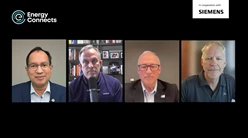What next after US and Gulf states seal headline investments in the energy sector?
US President Donald Trump’s Gulf state visits proved, as expected, to be more about business deals than politics. AI, crypto, microchips, finance, aerospace, healthcare, real estate, were all on the agenda. But it’s energy that was one of the most attractive destinations for investment – both into the Gulf, and the US.
The Gulf has indeed moved into the US energy sector more deeply recently, mostly with gas deals for Saudi Arabia, Abu Dhabi National Oil Company (ADNOC) and Abu Dhabi strategic investor Mubadala. ADNOC’s new XRG unit is said to be looking for more gas assets in the US. In sharp contrast to oil, US gas prices have risen this year, and are supported by the rush to power data centres for AI.
During President Trump’s tour, the UAE committed to investing $440 billion in the US energy sector over the next decade, up from the current $70 billion. This includes the first primary aluminium smelter built in the US since 1980, which Emirates Global Aluminium will build in Oklahoma. Interestingly, XRG will also look at a 0.5 million tonne per year plant to capture carbon dioxide directly from the air, in partnership with Occidental in Texas.
Shale specialist enters Abu Dhabi
Conversely US companies will put $60 billion into UAE energy projects. This includes the entry of shale specialist EOG into Abu Dhabi, along with further investments by Occidental and ExxonMobil.
The state visit also brought deals for Saudi Arabia, said to total $600 billion: in particular, memoranda of understanding and agreements potentially worth $90 billion for Saudi Aramco, covering gas, chemicals, AI and other areas. Most notable was progress on three US LNG projects, Port Arthur with Sempra Energy, Louisiana with Woodside, and Rio Grande with Next Decade, with Aramco purchasing gas and/or investing. And the state oil giant will invest $3.4 billion in upgrading its Motiva refinery in Texas, the biggest in the US.
Stake in Golden Pass LNG plant
Qatar, which had no eye-catching energy announcements this time, has had a share in the under-construction Golden Pass LNG plant in Texas with ExxonMobil since 2019.
Going the other way, Riyadh has long sought a “123” deal on civil nuclear power cooperation. But it wants to be able to enrich uranium domestically, which traditional US policy has generally ruled out. It now appears Washington is no longer conditioning a 123 agreement on Saudi recognition of Israel, which remains out of reach while Israel continues its abandonment of the ceasefire and blockades Gaza. But President Trump’s visit brought no public progress in this area.
Scope for processing minerals
The Saudi and US energy ministries did agree to cooperate on mining and processing critical minerals, a less contentious and more straightforward area. Saudi Arabia has resources of gold, copper, phosphate, rare earths and other minerals of strategic importance. Both it and the UAE have invested significantly recently in resources in Africa. Non-Chinese sources are of keen interest to Washington. The Gulf, with its low energy costs and central geography, could also be a good place for processing minerals, an area where China is even more dominant than in their extraction.
However, the trip left behind two major contradictions.
First is the direction of investment. US Energy Secretary Chris Wright said in April: “It's going to involve investments both ways, massive UAE investments in the United States, and we’re going to see continued geo-strategic co-operation with the UAE.”
Oil price outlook
Saudi Arabia has been struggling to achieve its targets for attracting foreign direct investment. Oil and gas, petrochemicals, power generation, mining are among its strongest suits for wooing FDI. But it’s not clear the US has much to offer. American companies do feature in the minerals sector, and GE Vernova signed up during the visit to provide $14.2 billion of gas turbines and other systems. But recent investment and supply of equipment for areas from refining to solar to electric vehicles has much more preferred Chinese, Taiwanese and South Korean companies.
Going the other way, President Trump has demanded lower oil prices to curb inflation. OPEC+ has obliged, though for its own, different reasons, instituting two large production increases. Lower oil prices, consequent on higher production as well as the economic worries triggered by tariffs, mean the Gulf countries have less to spend overseas, alongside heavy domestic development priorities. A possible deal with Iran over its nuclear programme would release yet more oil on to the market.
That matters less for deep-pocketed Qatar and the UAE, but it does challenge Saudi Arabia. The requested $1 trillion investment by the Kingdom in the US, always implausible, now is absolutely out of reach.
Contrasting forecasts for US drilling
It is understandable that during the visit, the oil exporters wanted their production policy to seem in accordance with President Trump’s wishes, and with internal discipline, not with bashing a successful American industry. But that is the practical outcome. Lower prices have already led to a slowdown in US drilling, and could lead to a stagnation or even decline in output this year, contrasting with forecasts of just three months ago for significant growth. Valuations in the US shale patch may be more attractive, but a shadow has fallen over its longer-term future.
The second contradiction is in US domestic energy policy. Renewable and nuclear power and electric vehicles are all attractive areas for Gulf investors. In October, after buying independent US renewable generator Terra-Gen, Abu Dhabi clean energy investor Masdar said it saw the US as one of its fastest growth markets, and targeted 10 gigawatts of capacity there out of its overall target of 100 GW by 2030. Saudi Arabia’s Public Investment Fund holds more than 58 percent of the shares of electric carmaker Lucid.
But the Trump administration is not friendly to energy other than oil and gas, even nuclear which initially seemed favoured. The budget bill now making its way through Congress looks set to gut nearly all support for solar, wind, hydrogen, nuclear, batteries and electric vehicles.
Eye-catching announcements
Both the GCC countries and President Trump got what they wanted from the tour: some specific deals, eye-catching announcements, warm words and no public clashes over controversial issues.
The headline investment numbers from the three Gulf countries are massive, with a fair share of double-counting and repeats of previous commitments. The reality will be somewhat less, and some of the roads to the energy future are barred, for now.
- Robin M. Mills is CEO of Qamar Energy, and author of The Myth of the Oil Crisis
Energy Connects includes information by a variety of sources, such as contributing experts, external journalists and comments from attendees of our events, which may contain personal opinion of others. All opinions expressed are solely the views of the author(s) and do not necessarily reflect the opinions of Energy Connects, dmg events, its parent company DMGT or any affiliates of the same.






